We’ve found that successful bass fly fishing starts with the right gear: a 6-weight rod paired with a disc drag reel handles those fighters perfectly. Match your line to water depth—floating for shallows, intermediate for middle depths, and sinking for structure fishing. Don’t forget your fly arsenal: poppers, Woolly Buggers, Clousers, and foam bugs trigger those explosive strikes. Your retrieval technique matters too—slow in weeds, quick near timber. The right approach turns those missed opportunities into trophy catches.
Essential Gear for Successful Bass Fly Fishing
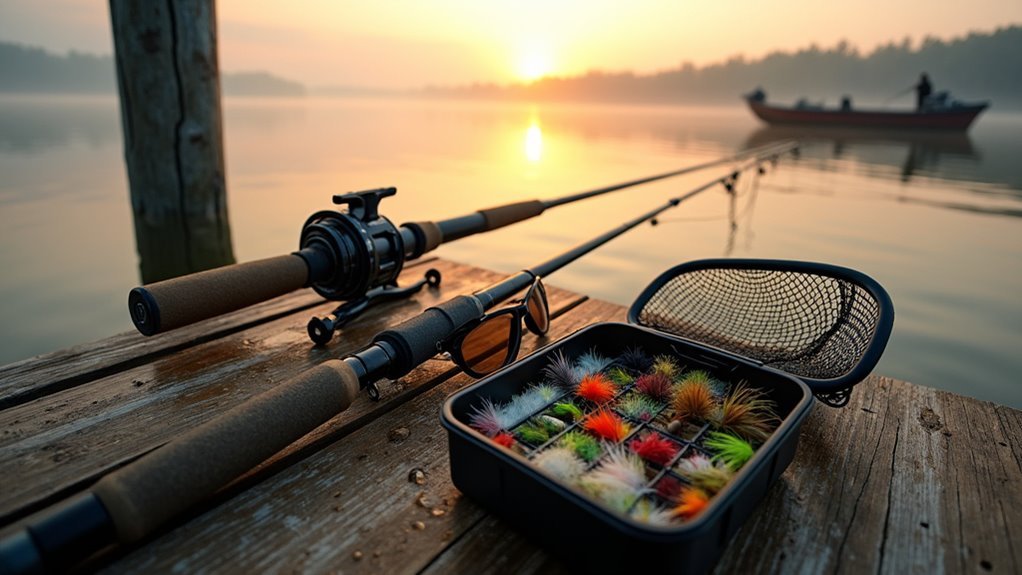
While many anglers plunge into bass fly fishing with misconceptions about its complexity, having the right gear can make all the difference between frustration and success on the water. We’ve learned this the hard way after countless trips home empty-handed!
For bass, we recommend a 6-weight rod that can handle these fighters. Trust us, you’ll want that extra backbone when a chunky largemouth explodes on your popper. Pair it with a disc drag reel for smooth control, and select your fly line based on depth – floating for shallows, intermediate for mid-depth, and sinking for structure fishing.
Selecting the Perfect Fly Rod Weight for Bass
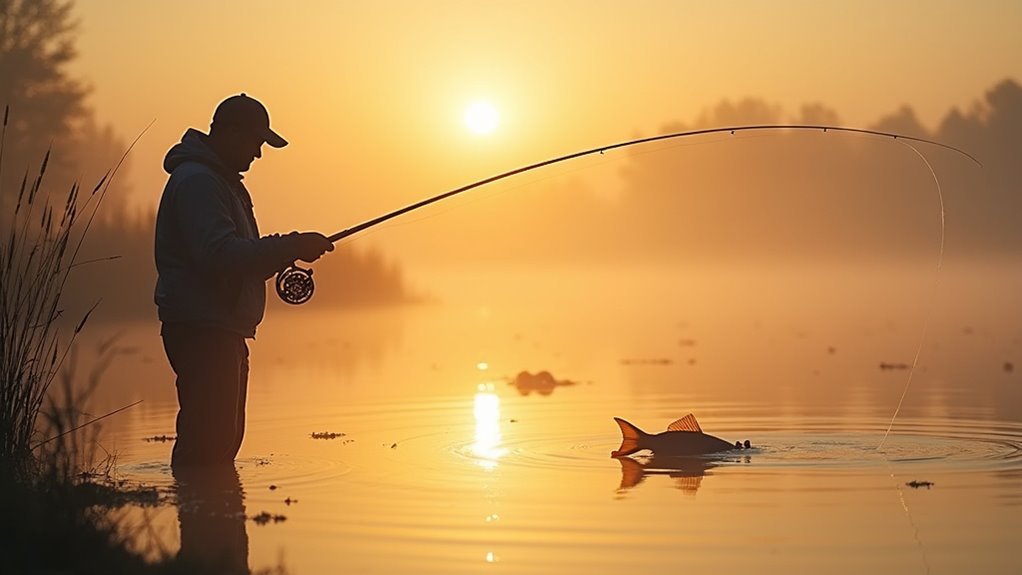
Since the right rod can make or break your bass fishing adventure, choosing the proper weight deserves serious attention. We’ve found that a 6-weight rod hits the sweet spot for most bass situations. Though rods range from 5-8 weight, we prefer erring on the heavier side.
When we’re battling an angry largemouth that’s bulldogged into a sunken tree, we’re grateful for that extra backbone. Last summer, my buddy Mike tried using his trout setup for bass and nearly snapped it on a 4-pounder! Remember, these fighters demand sturdier gear than delicate trout rods.
Understanding Fly Line Options for Different Water Conditions
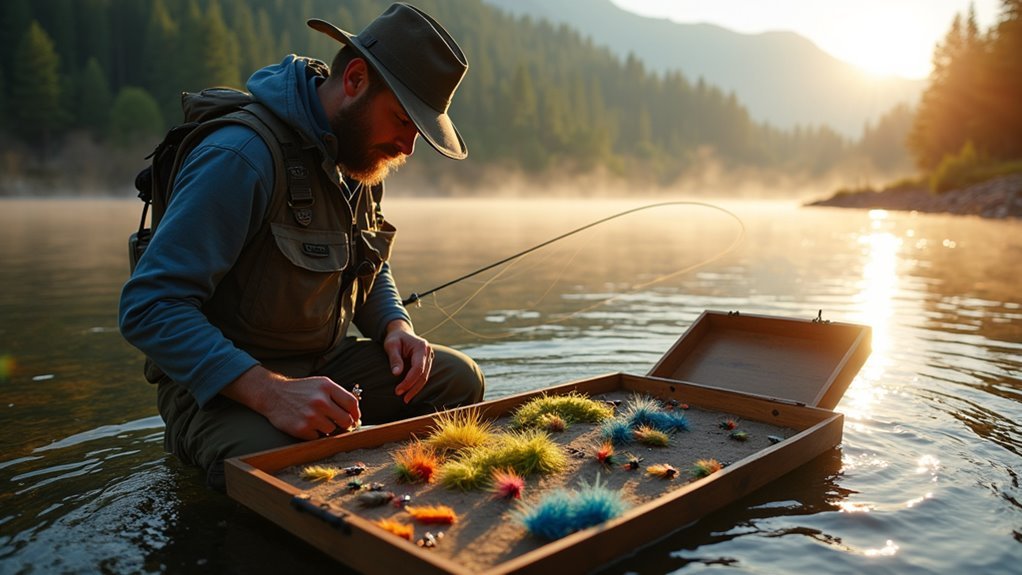
Now that you’ve got the right rod in hand, let’s talk about what you’ll string it with. When it comes to bass fly fishing, your line choice makes all the difference.
We typically work with three main fly line types. Floating lines are our go-to for shallow water and river fishing where bass are near the surface. For that middle depth range—about six to ten feet down—intermediate lines shine. When those lunkers are hugging the bottom or hiding near deep structures, sinking lines are your best friend.
I’ve learned this the hard way after many fishless afternoons!
Top Fly Patterns That Bass Can’t Resist
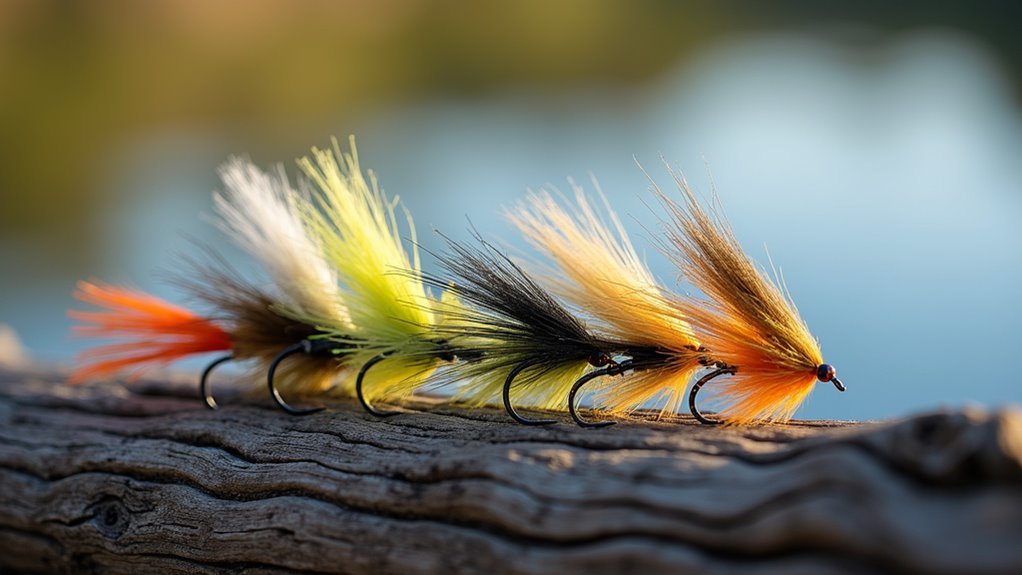
After years on the water, I’ve discovered that bass have definite preferences when it comes to fly patterns. We’ve found that poppers are absolute dynamite during summer mornings, creating that irresistible “blooping” sound that drives largemouth crazy.
Woolly Buggers consistently produce strikes when worked slowly near structure. For deeper water, we rely on weighted Clouser Minnows – they dive quickly and mimic injured baitfish perfectly.
Don’t overlook foam bugs like the deer hair mouse. Once, at dusk, I watched a three-pounder absolutely demolish one! The strike was so violent, it nearly yanked the rod from my hands.
Effective Retrieval Techniques for Various Bass Habitats
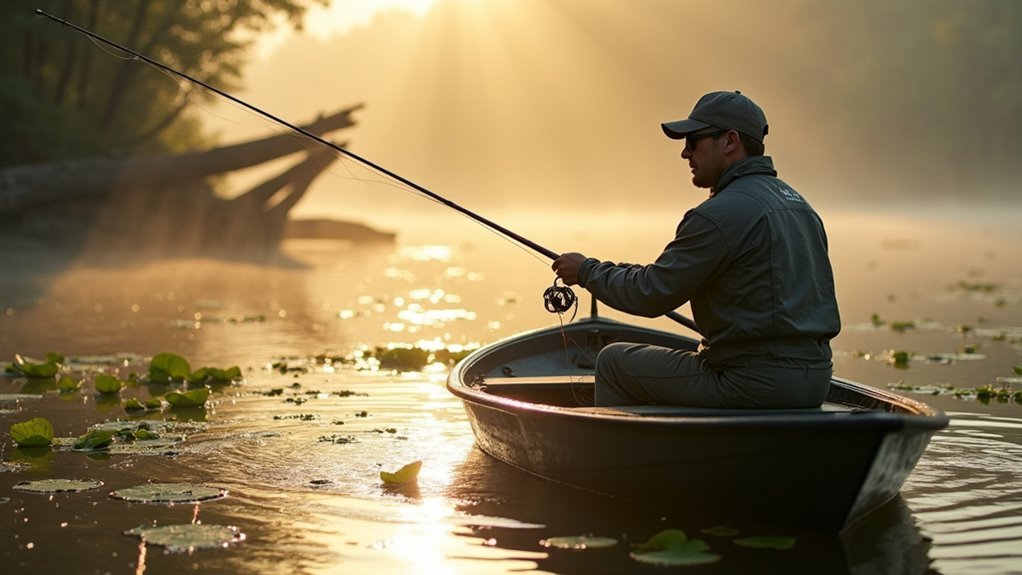
While mastering the right fly pattern is essential, knowing how to retrieve it properly can make the difference between a day of constant action and going home skunked. We’ve found that habitat dictates retrieval speed and style dramatically.
In weedy areas, a slow, methodical strip with pauses works wonders – letting bass track your fly through clearings. Near fallen timber, quick, erratic strips that imitate panicked baitfish trigger instinctive strikes. Once, I watched a five-pounder rocket from under a dock when I added a sudden twitch after a dead drift.
Strategic Locations to Target Bass in Lakes and Rivers
Understanding where bass hide is equally important as knowing how to retrieve your fly. We’ve found that bass love structure – look for fallen trees, submerged logs, and dock pilings where they ambush prey.
In lakes, we target weed edges and drop-offs, especially during morning and evening hours when bass are actively feeding. In rivers, focus on slack water behind large rocks or along undercut banks.
We once discovered a honey hole behind a partially submerged stump that produced bass after bass! Remember to cast near shade – bass often retreat to cooler water when the sun’s high. This simple knowledge can transform your fishing success.
Timing Your Fishing to Match Bass Feeding Behavior
When the sun barely peeks over the horizon, bass begin their daily feeding frenzy. We’ve learned this prime time can’t be beaten for topwater action. They’re also hungry at dusk when shadows stretch across the water.
We always keep our rod tips pointed down during retrieval—it dramatically improves hook-setting. Try pausing during your retrieve; we’ve noticed bass often strike during these moments of stillness.
During summer heat, we target early mornings and late evenings exclusively. In spring and fall, midday fishing becomes more productive. Remember, consistency pays off—when you find what works, stick with it!
Overcoming Common Challenges in Bass Fly Fishing
Despite our enthusiasm for bass fly fishing, we’ve all faced those frustrating moments when nothing seems to work. Last summer, I spent hours casting at a lake without a single strike until I adjusted my approach.
Patience and adaptation turn frustrating casts into successful bass fishing adventures.
Three common challenges and solutions:
- Incorrect Fly Selection – Match your flies to local forage and water conditions
- Poor Casting Accuracy – Practice targeting specific spots, not just general areas
- Impatient Retrieval – Slow down and vary your retrieve speed; bass often strike during pauses
Frequently Asked Questions
How Do Seasonal Changes Affect Bass Fly Fishing Strategies?
We adapt our strategies seasonally. In spring, we target spawning areas; summer calls for deeper water tactics; fall requires more aggressive retrieves; and winter demands slow, deep presentations near structure.
Can I Fly Fish for Bass From a Kayak Effectively?
Ever wondered if a kayak works for bass fly fishing? We’ve found it’s extremely effective! You’ll access spots unreachable from shore, maintain stealth, and have better casting angles. Just secure loose gear and practice kayak-specific casting.
What Leader and Tippet Setups Work Best for Bass?
We recommend a 7-9 foot tapered leader in 10-15 pound test for bass. Add 12-20 pound fluorocarbon tippet depending on cover density. Shorter, heavier setups work best for larger flies and heavy structure.
How Should Fly Casting Technique Differ for Bass Versus Trout?
We need MONSTER casts for bass compared to trout! We’ll use more powerful, aggressive casting motions for bass, often with heavier flies. With trout, we’re more delicate and precise to avoid spooking them.
Are Certain Fly Colors More Effective During Specific Weather Conditions?
We’ve found that darker flies work better on overcast days, while brighter colors excel in sunny conditions. Natural tones are effective in clear water, and fluorescent patterns stand out when visibility is poor.
Conclusion
We’ve shown you the secrets that’ll transform your bass fly fishing from frustrating to phenomenal! Armed with these techniques, you’ll be hauling in monster bass that’ll make your fishing buddies’ jaws drop to the ground. We’ve weathered countless sunburns and early mornings to perfect these methods, and now they’re yours. Remember, there’s nothing quite like the explosion of a largemouth attacking your popper—it’s why we keep coming back, cast after cast!